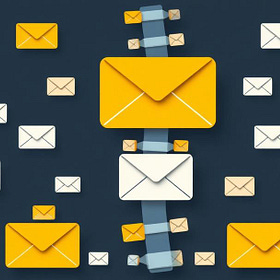The Email Strategy Matrix: How to Prioritize Your Next Move
Week 3 of the Making Time Email Mastery Series
TLDR: Not all email types are equally important for your business right now. A simple 2x2 framework helps you prioritize certain kinds of email to work on based on your market, business model, and organization maturity.
Read Time: 4 minutes
Hi Timeless Leaders,
We had our July Basecamp call this morning, and with excitement welcomed new members and had deep dialogue about freedom and time management.
Now I’m excited to bring it back to email!
(What do you think of this series? Does it land? You’ll have to give me feedback after you read. We’ve got 5 more left and I want to hear from you!)
After last week's post (“Email is Your Business Backbone”), you might have been wondering: "Where do I start? What should I focus on now?"
Great question!
This week, let’s look at how different emails perform for different purposes and stages, and this can help you decide what part of your email strategy to focus on next.
The 2x2 Email Strategy Matrix
On the X-Axis, we plot the Relationship Stage (Cold → Warm), with emails on the left side focused on opening up a conversation and validating needs, while emails on the right side focus on deepening trust and delivering value.
On the Y-Axis, we look at Volume & Automation (Human Scale → Machine Scale). Emails on the bottom are handled manually, one-by-one or in small batches, and focus on personalization and the human touch. Emails at the top focus on scaling what works (or what you want to test more quickly), using AI and automation to replicate the human interaction with less oversight, but more speed.
Two Ways to Use This Matrix
A mature organization will likely have email running in at least 3 or possibly all 4 quadrants. To determine which quadrant deserves the most attention for your business, there are two ways you can approach it:
Path 1: Business Maturity Progression
Most businesses naturally evolve 1→2→3→4 as they grow:
Quadrant 1 - Prospecting: Learn your market through manual outreach
Quadrant 2 - Relationship Building: Deepen connections with early supporters
Quadrant 3 - Scaled Outbound: Automate what worked manually
Quadrant 4 - Lifecycle Marketing: Nurture your growing audience systematically
You start manually, and as you know what works, you accelerate and scale it with machines.
Path 2: Market Segment Requirements
Choose your quadrant based on your business model and who you're selling to:
Mid-Market & Enterprise: Machine scale can work, but you’ll always need to handle quadrants 1 & 2 (manual/personal) well, for strategic, relationship-driven sales. You scale these much later than in other segments
SMB: Stand up machine scale as early as possible (quadrants 3 & 4) due to lower LTV and higher volume of deals
B2C: Scaled outbound can violate SPAM laws (and logic), so after you use email to generate leads manually (Quadrant 1) you probably shift to primarily using non-email methods to get leads at scale. Meanwhile, where you definitely will want to invest in email at scale is Quadrant 4.
Real-World Examples
Here are four examples of how these quadrants have applied with work I’ve done since 2017:
Box (100K customers in all segments): Used all four quadrants, but the biggest challenge was coordinating outreach across different personas in complex enterprise accounts. Team coordination eliminated gaps and redundancy. Integration with product notifications and other marketing channels made the biggest difference.
Slate (7-figure business targeting mid-market companies): Started with Quadrant 3 (scaled outbound) but wasn't getting quality leads. Backtracked to Quadrant 1 (targeted manual outreach to ideal firms), which paired perfectly with our event strategy. Sometimes you need to go backwards to go forwards.
Edstruments (focused on growing with small and medium sized orgs): We had been heavily focused on Quadrants 1 & 2 (manual prospecting and relationship building) but almost nothing in 3 or 4. We stood up Quadrant 3 (scaled outbound) to accelerate identification of in-market buyers without losing the personal touch.
This Substack (seeking to add new readers and deepen their loyalty): Special case since the product IS email newsletters. Growth comes primarily from Quadrant 1 (manual cold outreach). Currently testing ways to expand into all three other quadrants.
Your Next Move
Pick ONE quadrant that most needs attention in your business right now. Ask yourself:
If you're early-stage: Are you spending enough time in Quadrant 1?
If you have traction: Should you be scaling to Quadrant 3?
If you have an audience: Is your Quadrant 4 working?
If you're established: When did you last focus on Quadrant 2?
Spend the next two weeks either sending those emails or setting up the systems for your chosen quadrant.
Which quadrant will you focus on first?
Talk soon,
-Joe
P.S. Next week we're exploring the CEO's role in email strategy—how to provide strategic direction without micromanaging execution. If you're getting value from this series, forward it to one colleague who's thinking about email strategy—they'll thank you for it.
PPS. This is part of a special series on Email, which previews how the upcoming season “Making Time” will exploring how leaders design and allocate time for their teams. Catch up from previous weeks below!
Building a Winning Hand: The 8 Email Types That Drive Growth
This is the first post in a weekly deep-dive into the systems, strategies, and frameworks that drive sustainable business growth. As I’ve said earlier, "2025 is the Year of the Email" (and you’re probably seeing this as an email), therefore I'm kicking off with an 8-week series on email as a growth lever
Email is Your Business Backbone
This is Week 2 of the Email Mastery Series - A Making Time (Season 3) Preview




